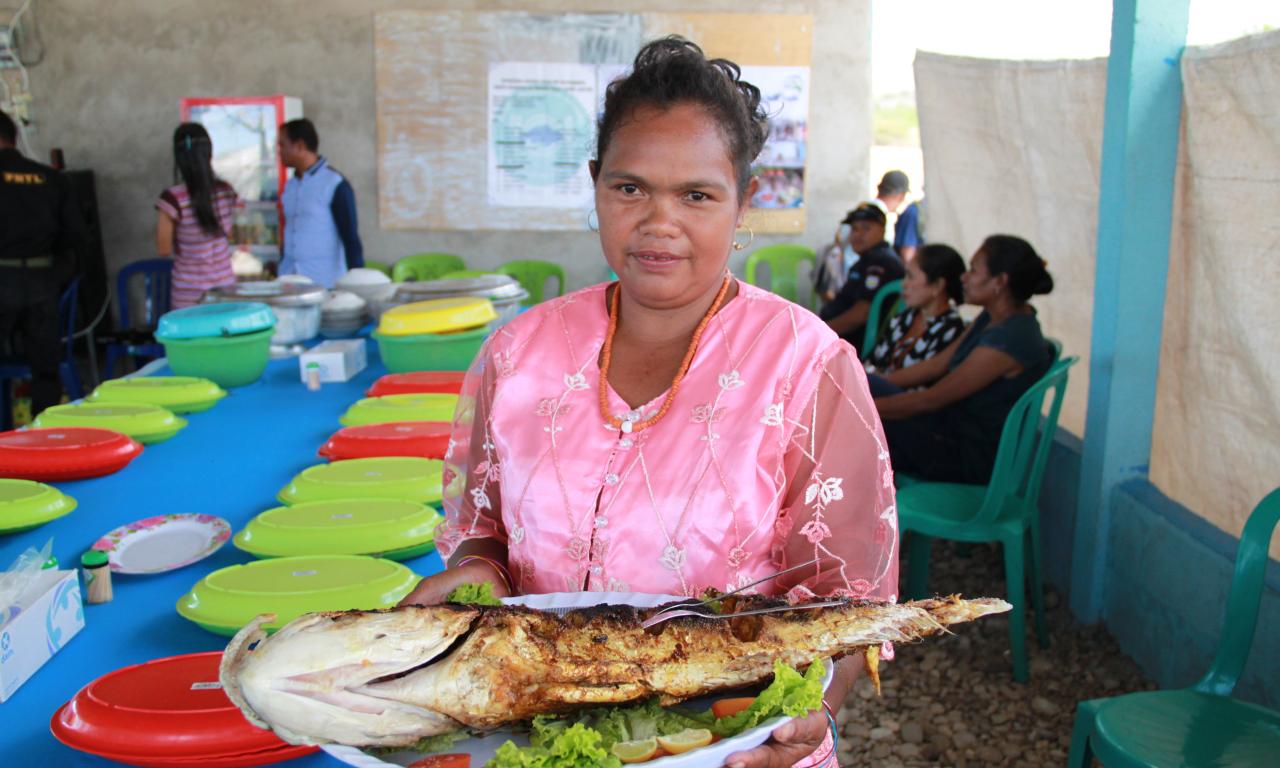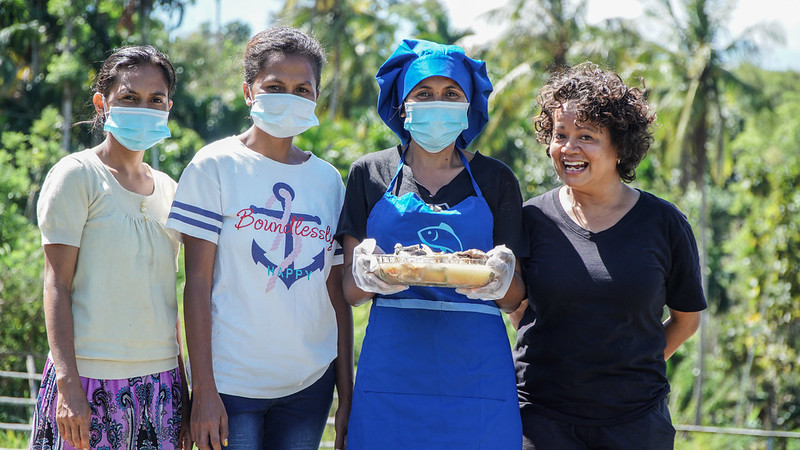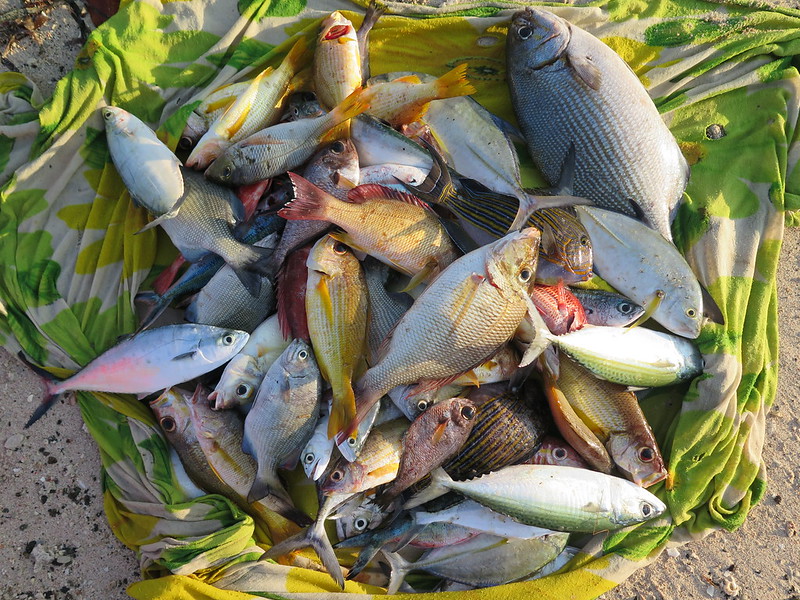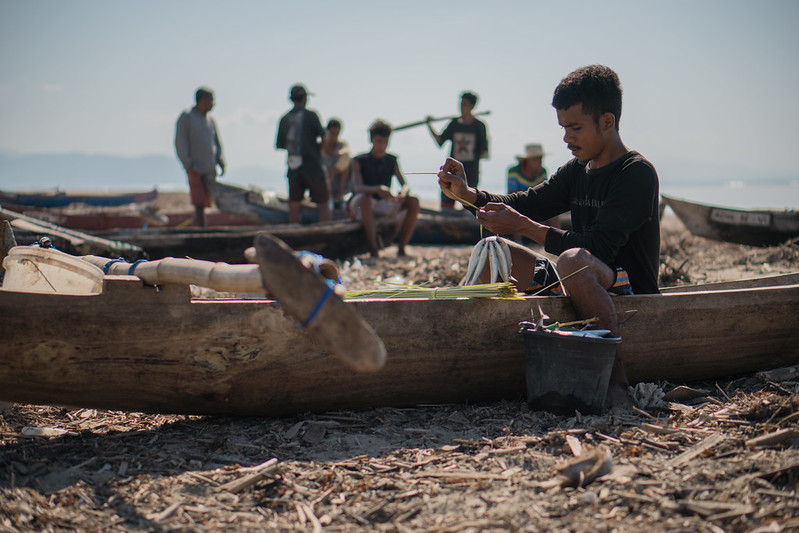
- A new cookbook celebrates aquatic foods and the people who prepare them in the island nation of Timor-Leste
- Aquatic foods have the potential to improve health and nutrition in the country while supporting rural livelihoods
Since achieving its independence 20 years ago, Timor-Leste has set out to forge a cohesive national identity. The nation’s culinary history, deeply tied to the sea, offers a starting point to define the culture. However, industrialized food systems have made traditional foods and customs inaccessible to many Timorese and led to a cultural disconnect.
A new cookbook by WorldFish research analyst and Timor-Leste native Agustinha Duarte, Cooking Fish and Seafood in Timor-Leste, aims to change that by documenting the rich influence fish and other aquatic foods have had on human nutrition, identity and livelihoods across the island nation. Journeying through five municipalities over three years, Duarte set out to record traditional recipes that connect the Timorese people to their ancestral practices at a time when diets are shifting away from cultural staples towards processed foods.
The resulting recipe collection incorporates only locally available ingredients, in attempts to move islanders away from packaged foods with poor nutritional value that contribute to one of the highest rates of child malnutrition in the world. Conversely, fish are rich in vitamins and micronutrients that support optimum cognitive and physical development in children.
The book aims to provide inspiration to all Timorese, especially the younger generation, to eat more nourishing aquatic foods and spark a national conversation on fish for all. However, as it stands, fish are often cost-prohibitive for many rural low-income communities.
“Despite a history of nutritious aquatic foods in local diets, industrialized food systems have made fish and other aquatic foods too expensive for many Timorese and inaccessible to inland communities. A growing dependence on nutrient-poor imported foods like instant noodles have also led to surging rates of malnutrition and heart disease,” said Duarte.
Throughout her book, Duarte celebrates the nation’s biodiverse waters and rich aquatic resources, while exploring their potential to support healthy equitable diets and household income. She recorded the diverse practices of fisheries actors she met while on her voyage, who creatively harvested natural resources to develop nutritious, delicious meals and value-added retail products.
Written in the official language Tetun with English translations, the book seeks to instill pride in the Timorese people and their traditional aquatic foods, offering them a culturally and geographically unique food identity.

The book was produced as part of WorldFish’s fish-based livelihoods project in Timor-Leste and undertaken as part of the CGIAR Research Program on Fish Agri-Food Systems (FISH), with funding from SwedBio, a program for biodiversity and equitable development at the Stockholm Resilience Centre, and the Australian Centre for International Agricultural Research (ACIAR).
“These recipes and stories of sustainable aquatic food production provide a catalyst for people to reconnect with culinary traditions that promote health and well-being, while reminding us of the importance of preserving marine ecosystems for the millions that depend upon them,” said Prof. Ann Fleming, the ACIAR Research Program Manager for Fisheries, who supported publishing of the book.
“At a time when food and nutrition security has rapidly risen on the list of development priorities, the Timorese WorldFish team is leading the way with research and practice to advance the Sustainable Development Goals, targeting malnutrition and the preservation of life below water,” said Max Troell, senior researcher responsible of the project at SwedBio.
Aquatic foods for a nourished population

In the book’s foreword, former Timor-Leste President and Nobel Peace Prize Winner José Ramos-Horta championed the power of aquatic foods to transform the health of people across the nation while upholding cultural traditions.
“It (the book) reminds and teaches us how to use our local products and the cooking traditions of our ancestors—foods and traditions that have nutritional value, historical origins firmly rooted in Timor-Leste and live on from generation to generation,” he wrote.
Ramos-Horta acknowledged the work of the Government of Timor-Leste and its international partners in promoting inclusive and resilient aquatic food systems, and encouraged the development of innovative fish-based products to improve access in non-coastal communities.
“As much as the book celebrate traditional foods, it also illustrates successful innovation in aquatic food systems. Aquaculture of affordable fish species and the development of fish-based products with extended shelf-life are two demonstrable initiatives that have enhanced the local production and accessibility of nutrient-rich foods,” said Hampus Eriksson, co-author and senior scientist at WorldFish.
One key initiative to increase fish consumption has been the development of a national fish hatchery to breed and farm genetically improved tilapia strains, known as GIFT, through a partnership between WorldFish and the country’s Ministry of Agriculture and Fisheries.
Tilapia farming has resulted in both higher incomes and increased fish consumption in Leohitu village, located on the southwestern edge of Timor-Leste. Exploring the region’s hatcheries—dedicated to the breeding, hatching, and rearing of young tilapia—the cookbook includes a recipe for ‘Tilapia soup from Leohitu,’ given to Duarte by Imelia Noronha, a local fish farmer. Noronha has experimented with various tilapia recipes since her family opened its own hatchery.
Developing value-added fish products like dried fish powder has also improved access of critical nutrients to undernourished communities while creating new business opportunities in aquatic foods production. Surplus fish can be dried and ground into powder, increasing shelf life where cold storage is limited, and is easily transported to rural inland provinces.
Cooking Fish and Seafood in Timor-Leste instructs readers to make dried fish powder using mackerel, shrimp and moringa leaves, which are rich in protein and micronutrients vital for health and development. The powder can be mixed into rice porridge, vegetable soups and other dishes to add flavor and nutritional value. Fish powder can also be incorporated into school feeding programs and hospitals to increase nutrient consumption in at-risk populations.
"To support the health and well-being of the Timorese people, we must highlight the role of aquatic foods in nutritious diets and work to increase their consumption in vulnerable groups, especially young children and pregnant and lactating mothers," said Duarte.
Preserving and building upon traditions

Each recipe is introduced by a story about a practice, species or person. Narratives range from the long journey of a mud crab from the southern coast to the capital city of Dili, to Duarte’s childhood memories of ikan saboko, or fish baked in palm leaves. The text honors the customs and meals of past generations and pays homage to all those who partake in the production and processing of aquatic foods.
The book also underscores the influence of women in aquatic food value chains, especially those participating in typically male-dominated harvesting activities. Timorese women often perform gleaning activities, collecting marine resources like seaweed, crabs, and mussels from rocky reefs exposed at low tide, both to sell and cook for their families.
Along the Loes River in the Bobonaro municipality, fisher women construct traps to capture freshwater shrimp and hawk them to roadside passers. Shrimp are crucial to the country’s culinary history; hand-woven nets were once used in harvesting, but women now prefer to fashion traps from plastic bottles. The unsold shrimp of the day are used to cook boek kari or shrimp curry, and Duarte details its preparation in the recipe collection.
“Preserving the original recipes of our ancestors is crucial,” said Duarte. “Restaurants in Dili often change them for the worse, and part of our heritage is lost, along with its nutritional knowledge.”
Positioning seafood as a staple of the identity of Timorese people, the book celebrates the fledgling nation’s culinary traditions and underscores the importance of fish and aquatic foods in coastal and rural livelihoods.
Another recipe for ikan tukir or fish cooked in bamboo, is introduced by a narrative detailing the grandfathers and great grandfathers of Timor-Leste, who traveled vast distances on foot in hunting parties in search of buffalo. Instead of carrying heavy cooking equipment, they learned to cook foods using natural resources like bamboo and palm leaves.
“The foods and cooking methods that sustained the Timorese for generations are invaluable,” concluded Duarte. “I hope this book can demonstrate their importance to the younger generations and ensure nutritious diets for all.”
